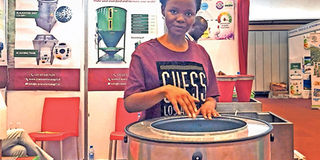Chicken slaughter made easier

Grace Oseko who works with the Special Foods International Company Ltd, explains a point on how the poultry slaughter unit works during a recent exhibition at the Sarit Centre in Nairobi. Thomas Junne Kaudia, the technical director at the firm said the poultry slaughter process must be hygienic from the outset. PHOTO | BRIAN OKINDA | NMG
What you need to know:
- Birds should be fed on a balanced diet and the feed withdrawn at least four hours before they are slaughtered
- The birds should also not be transported with their heads hanging downwards
- The slaughter unit is made up of three components, namely the bleeding assembly, which has four restraining cones, the scalding tank and the plucker.
- Mr Fred Kamau, an egg production specialist at Big Dutchman, a poultry housing and equipment distribution firm, noted that hygienic housing and feeding systems are essential for high productivity in poultry.
Do you know you can slaughter and pluck off the feathers of up to four chickens in less than five minutes?
And with just the click of a button, do you know you can manage production and other important aspects of your poultry farming enterprise, regardless of how many chicken coops you have?
Last week, Sarit Centre in Nairobi hosted an event where ground-breaking technologies that poultry farmers could harness to improve their productivity were showcased.
Improved poultry breeds, chicken housing and lighting systems, poultry feeding and drinking equipment, egg collection systems, heating systems as well as chicken slaughter systems, were all on display at the Agro & Poultry East Africa Exhibition 2019.
Thomas Junne Kaudia, a technical expert at Special Foods International Company Ltd, the makers of the slaughter unit, said the process must be hygienic from the outset.
“The birds should be fed on a balanced diet and the feed withdrawn at least four hours before they are slaughtered,” said Kaudia.
According to him, the four hours allow the birds to fully digest the feed to ensure their crops and innards are empty, as feed remnants in these internal organs may lead contamination.
He advised that rather than catch the birds by the legs before slaughter, one should pick them with their wings against their bodies. This stops them flapping their wings and bruising themselves.
The birds should also not be transported with their heads hanging downwards, according to Mr Kaudia.
The slaughter unit is made up of three components, namely the bleeding assembly, which has four restraining cones, the scalding tank and the plucker.
HYGIENIC HOUSING AND EQUIPMENT
“The birds are put headfirst into the cones — four at a time — and their jugular veins severed and left to bleed for two minutes. They are then put in the scalding tank for one-and-a-half minutes, where the water is heated to 58°C,” he explained, adding that leaving the birds in the tank for longer leaves them ‘cooked’.
The birds are then put in the plucker, which is a bucket-shaped device containing protrusions and a spinning base. According to Mr Kaudia, the machine de-feathers the birds in 22 seconds.
After de-feathering, Mr Kaudia advised, the right tools and processes must be used during cleaning, packaging and storing the slaughtered birds to avoid contamination.
Mr Fred Kamau, an egg production specialist at Big Dutchman, a poultry housing and equipment distribution firm, noted that hygienic housing and feeding systems are essential for high productivity in poultry.
The firm showcased a super double-deck and super triple-deck laying batteries, with two and three tiers, particularly for small-scale farmers keen on boosting productivity using the battery cage system.
The laying batteries come in basic, semi-automatic and automatic versions, depending on the farmer’s spending capability. The basic version is manually operated while the automatic version has most of its functions, such as feeding, done by an automatic feeding cart or an automatic feeding chain.
The Kenya Agricultural and Livestock Research Organisation (Kalro) exhibited their high-producing, resilient Kienyeji birds.
“These birds are hardy and lay up to 250 eggs per year and hardly sit on the eggs,” said Ochieng’ Ouko, a poultry researcher at Kalro, adding that not sitting on the eggs allows the birds to produce more.





